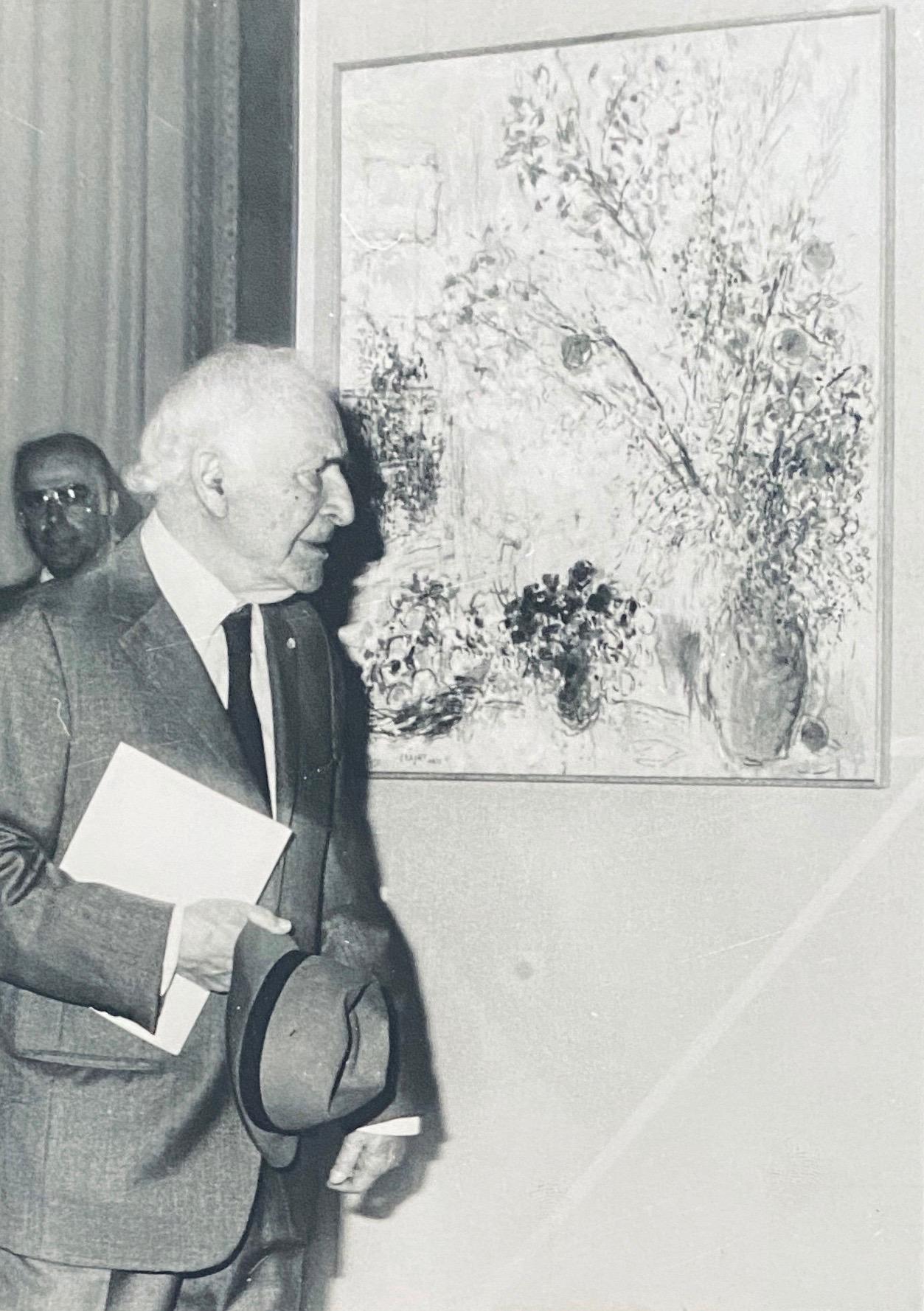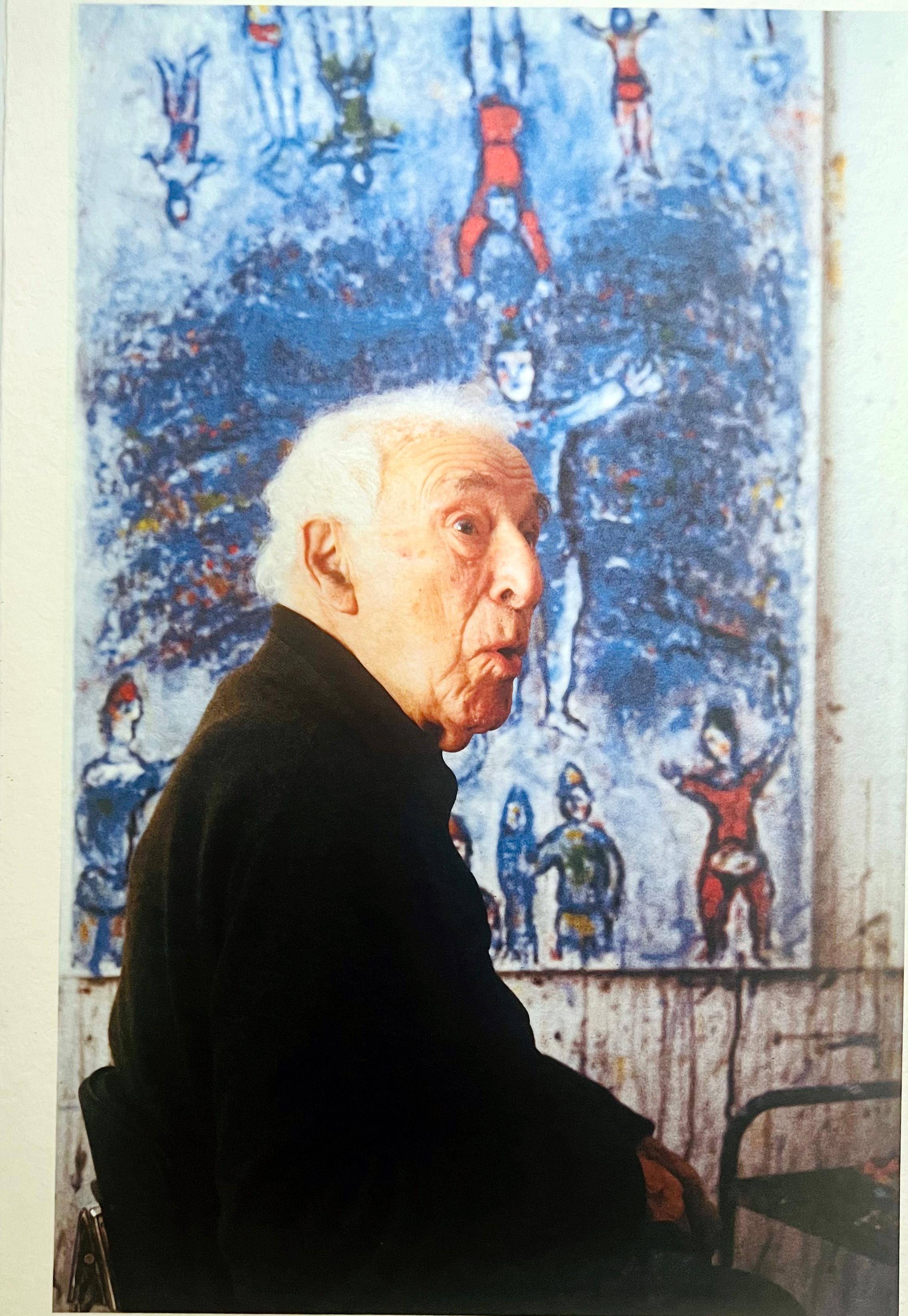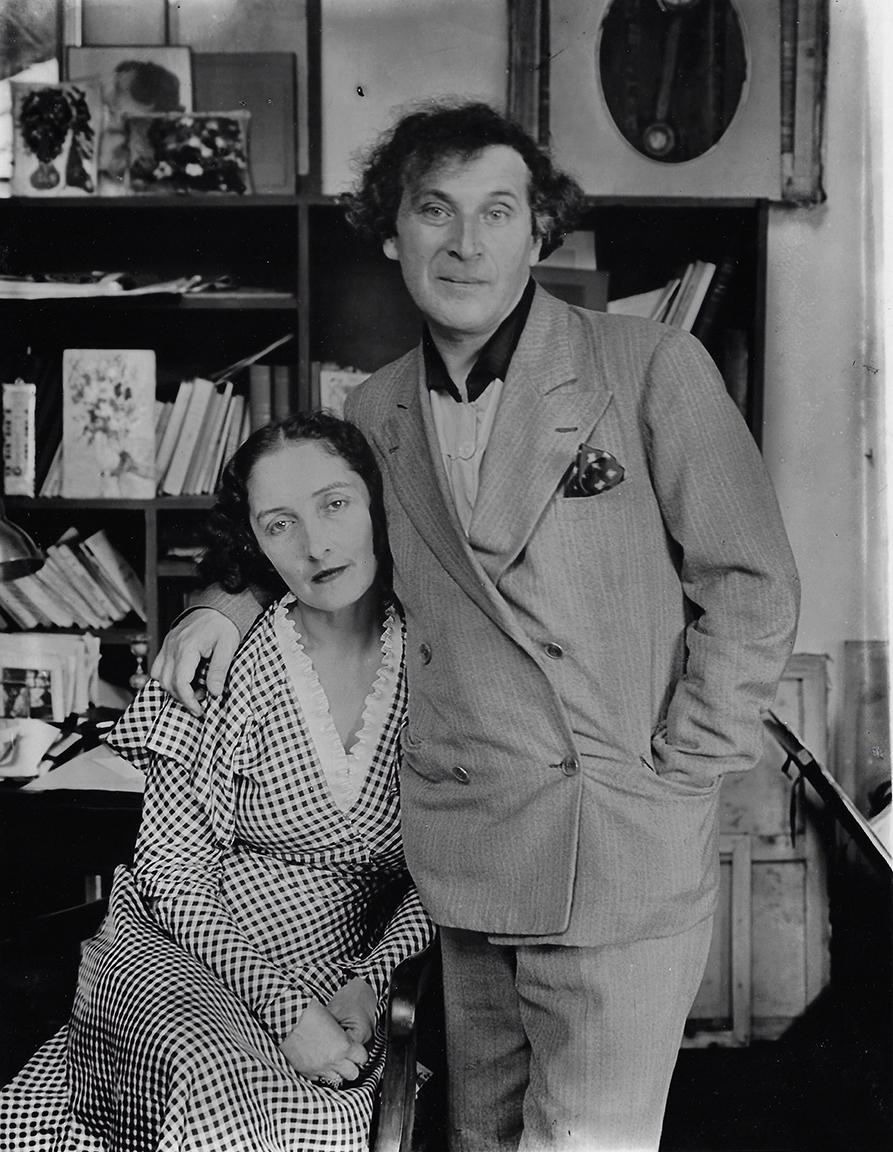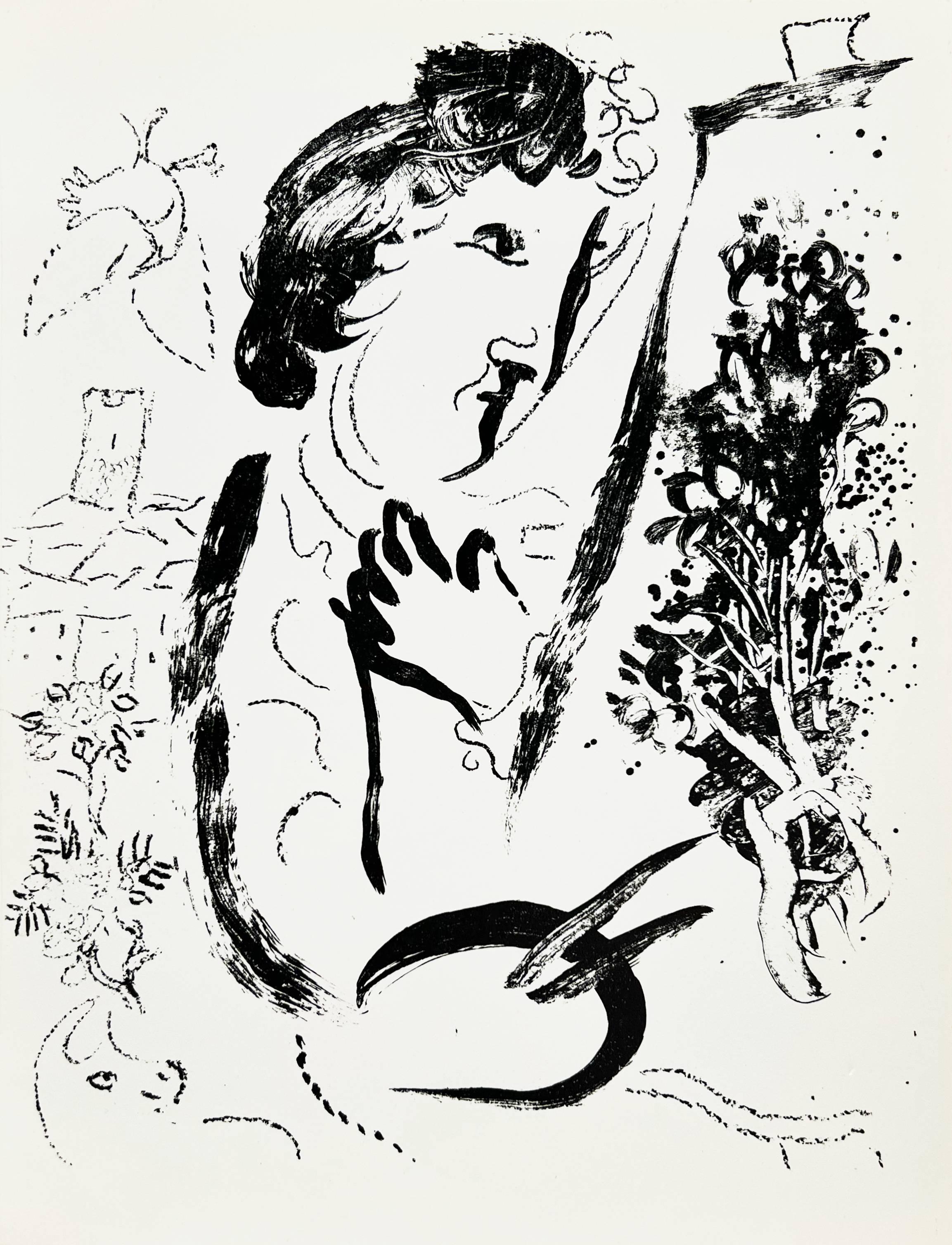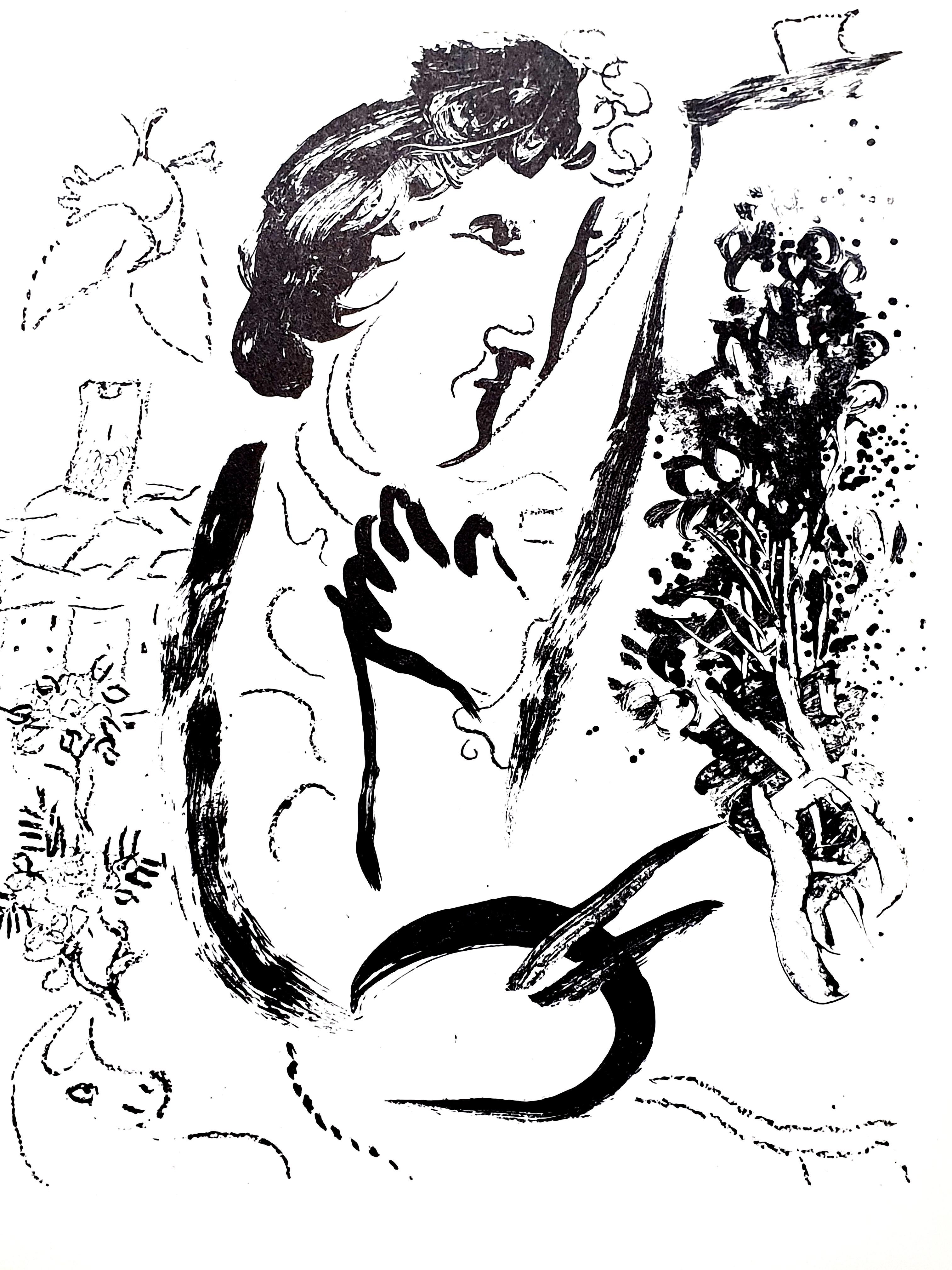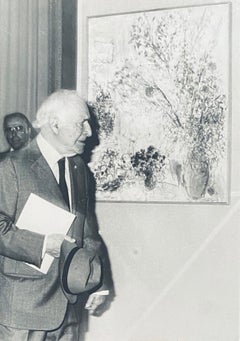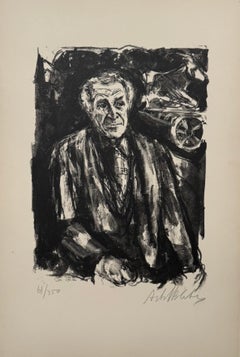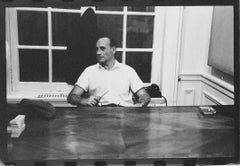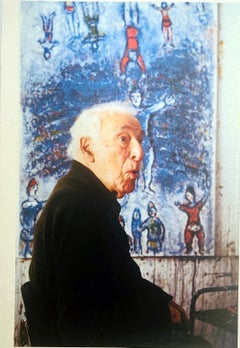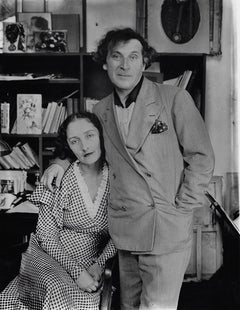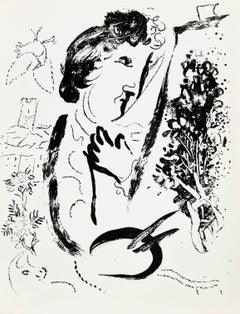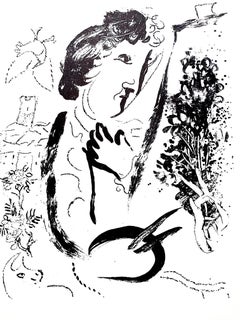Items Similar to Black And White Photograph Of Marc Chagall 1978
Want more images or videos?
Request additional images or videos from the seller
1 of 8
UnknownBlack And White Photograph Of Marc Chagall 19781978
1978
$300
£225.66
€260.11
CA$422.58
A$463.67
CHF 242.67
MX$5,706.26
NOK 3,057.22
SEK 2,863.54
DKK 1,942.25
About the Item
Marc Chagall (born Moïche Zakharovitch Chagalov; 6 July [O.S. 24 June] 1887 – 28 March 1985) was a Russian-French artist of Belarusian Jewish origin. An early modernist, he was associated with several major artistic styles and created works in a wide range of artistic formats, including painting, drawings, book illustrations, stained glass, stage sets, ceramic tapestries and fine art prints.
Art critic Robert Hughes referred to Chagall as "the quintessential Jewish artist of the twentieth century" (though Chagall saw his work as "not the dream of one people but of all humanity"). According to art historian Michael J. Lewis, Chagall was considered to be "the last survivor of the first generation of European modernists". For decades, he "had also been respected as the world's pre-eminent Jewish artist". Using the medium of stained glass, he produced windows for the cathedrals of Reims and Metz, windows for the UN and the Art Institute of Chicago and the Jerusalem Windows in Israel. He also did large-scale paintings, including part of the ceiling of the Paris Opéra.
Before World War I, he travelled between Saint Petersburg, Paris, and Berlin. During this period he created his own mixture and style of modern art based on his idea of Eastern European Jewish folk culture. He spent the wartime years in Soviet Belarus, becoming one of the country's most distinguished artists and a member of the modernist avant-garde, founding the Vitebsk Arts College before leaving again for Paris in 1923.
He had two basic reputations, writes Lewis: as a pioneer of modernism and as a major Jewish artist. He experienced modernism's "golden age" in Paris, where "he synthesized the art forms of Cubism, Symbolism, and Fauvism, and the influence of Fauvism gave rise to Surrealism". Yet throughout these phases of his style "he remained most emphatically a Jewish artist, whose work was one long dreamy reverie of life in his native village of Vitebsk." "When Matisse dies," Pablo Picasso remarked in the 1950s, "Chagall will be the only painter left who understands what colour really is".
Marc Chagall was born Moishe Shagall in a Lithuanian Jewish Hassidic family in Liozna, near the city of Vitebsk (Belarus, then part of the Russian Empire) in 1887. At the time of his birth, Vitebsk's population was about 66,000, with half the population being Jewish. A picturesque city of churches and synagogues, it was called "Russian Toledo", after a cosmopolitan city of the former Spanish Empire. As the city was built mostly of wood, little of it survived years of occupation and destruction during World War II.
Chagall was the eldest of nine children. The family name, Shagal, is a variant of the name Segal, which in a Jewish community was usually borne by a Levitic family. His father, Khatskl (Zachar) Shagal, was employed by a herring merchant, and his mother, Feige-Ite, sold groceries from their home. His father worked hard, carrying heavy barrels but earning only 20 roubles each month (the average wages across the Russian Empire being 13 roubles a month). Chagall would later include fish motifs "out of respect for his father", writes Chagall biographer, Jacob Baal-Teshuva. Chagall wrote of these early years:
Day after day, winter and summer, at six o'clock in the morning, my father got up and went off to the synagogue. There he said his usual prayer for some dead man or other. On his return he made ready the samovar, drank some tea and went to work. Hellish work, the work of a galley-slave. Why try to hide it? How tell about it? No word will ever ease my father's lot... There was always plenty of butter and cheese on our table. Buttered bread, like an eternal symbol, was never out of my childish hands.
One of the main sources of income of the Jewish population of the town was from the manufacture of clothing that was sold throughout the Russian Empire. They also made furniture and various agricultural tools. From the late 18th century to the First World War, the Imperial Russian government confined Jews to living within the Pale of Settlement, which included modern Ukraine, Belarus, Poland, Lithuania, and Latvia, almost exactly corresponding to the territory of the Polish-Lithuanian Commonwealth recently taken over by Imperial Russia. This caused the creation of Jewish market-villages (shtetls) throughout today's Eastern Europe, with their own markets, schools, hospitals, and other community institutions.
Chagall wrote as a boy; "I felt at every step that I was a Jew—people made me feel it". During a pogrom, Chagall wrote that: "The street lamps are out. I feel panicky, especially in front of butchers' windows. There you can see calves that are still alive lying beside the butchers' hatchets and knives". When asked by some pogromniks "Jew or not?", Chagall remembered thinking: "My pockets are empty, my fingers sensitive, my legs weak and they are out for blood. My death would be futile. I so wanted to live". Chagall denied being a Jew, leading the pogromniks to shout "All right! Get along!"
Most of what is known about Chagall's early life has come from his autobiography, My Life. In it, he described the major influence that the culture of Hasidic Judaism had on his life as an artist. Chagall related how he realised that the Jewish traditions in which he had grown up were fast disappearing and that he needed to document them. Vitebsk itself had been a centre of that culture dating from the 1730s with its teachings derived from the Kabbalah. Chagall scholar Susan Tumarkin Goodman describes the links and sources of his art to his early home:
Chagall's art can be understood as the response to a situation that has long marked the history of Russian Jews. Though they were cultural innovators who made important contributions to the broader society, Jews were considered outsiders in a frequently hostile society... Chagall himself was born of a family steeped in religious life; his parents were observant Hasidic Jews who found spiritual satisfaction in a life defined by their faith and organized by prayer.
Chagall was friends with Sholom Dovber Schneersohn, and later with Menachem M. Schneerson.
In Russian Empire at that time, Jewish children were not allowed to attend regular schools or universities. Their movement within the city was also restricted. Chagall therefore received his primary education at the local Jewish religious school, where he studied Hebrew and the Bible. At the age of 13, his mother tried to enroll him in a regular high school, and he recalled, "But in that school, they don't take Jews. Without a moment's hesitation, my courageous mother walks up to a professor." She offered the headmaster 50 roubles to let him attend, which he accepted.
A turning point of his artistic life came when he first noticed a fellow student drawing. Baal-Teshuva writes that for the young Chagall, watching someone draw "was like a vision, a revelation in black and white". Chagall would later say that there was no art of any kind in his family's home and the concept was totally alien to him. When Chagall asked the schoolmate how he learned to draw, his friend replied, "Go and find a book in the library, idiot, choose any picture you like, and just copy it". He soon began copying images from books and found the experience so rewarding he then decided he wanted to become an artist.
He eventually confided to his mother, "I want to be a painter", although she could not yet understand his sudden interest in art or why he would choose a vocation that "seemed so impractical", writes Goodman. The young Chagall explained, "There's a place in town; if I'm admitted and if I complete the course, I'll come out a regular artist. I'd be so happy!" It was 1906, and he had noticed the studio of Yehuda (Yuri) Pen, a realist artist who also operated a small drawing school in Vitebsk, which included the future artists El Lissitzky and Ossip Zadkine. Due to Chagall's youth and lack of income, Pen offered to teach him free of charge. However, after a few months at the school, Chagall realized that academic portrait painting did not suit his desires.
Author Serena Davies writes that "By the time he died in France in 1985—the last surviving master of European modernism, outliving Joan Miró by two years—he had experienced at first hand the high hopes and crushing disappointments of the Russian revolution, and had witnessed the end of the Pale of Settlement, the near annihilation of European Jewry, and the obliteration of Vitebsk, his home town, where only 118 of a population of 240,000 survived the Second World War."
Chagall's final work was a commissioned piece of art for the Rehabilitation Institute of Chicago. The maquette painting titled Job had been completed, but Chagall died just before the completion of the tapestry. Yvette Cauquil-Prince was weaving the tapestry under Chagall's supervision and was the last person to work with Chagall. She left Vava and Marc Chagall's home at 4 pm on 28 March after discussing and matching the final colors from the maquette painting for the tapestry. He died that evening.
His relationship with his Jewish identity was "unresolved and tragic", Davies states. He would have died without Jewish rites, had not a Jewish stranger stepped forward and said the kaddish, the Jewish prayer for the dead, over his coffin. Chagall is buried alongside his last wife Valentina "Vava" Brodsky Chagall, in the multi-denominational cemetery in the traditional artists' town of Saint Paul de Vence, in the French region of Provence.
- Creation Year:1978
- Dimensions:Height: 7 in (17.78 cm)Width: 5 in (12.7 cm)
- Medium:
- Period:
- Condition:Good, Please see photos.
- Gallery Location:Surfside, FL
- Reference Number:1stDibs: LU38215384772
About the Seller
4.9
Platinum Seller
Premium sellers with a 4.7+ rating and 24-hour response times
Established in 1995
1stDibs seller since 2014
1,803 sales on 1stDibs
Typical response time: <1 hour
- ShippingRetrieving quote...Shipping from: Surfside, FL
- Return Policy
Authenticity Guarantee
In the unlikely event there’s an issue with an item’s authenticity, contact us within 1 year for a full refund. DetailsMoney-Back Guarantee
If your item is not as described, is damaged in transit, or does not arrive, contact us within 7 days for a full refund. Details24-Hour Cancellation
You have a 24-hour grace period in which to reconsider your purchase, with no questions asked.Vetted Professional Sellers
Our world-class sellers must adhere to strict standards for service and quality, maintaining the integrity of our listings.Price-Match Guarantee
If you find that a seller listed the same item for a lower price elsewhere, we’ll match it.Trusted Global Delivery
Our best-in-class carrier network provides specialized shipping options worldwide, including custom delivery.More From This Seller
View AllBlack And White Photograph Of Marc Chagall 1978
Located in Surfside, FL
Marc Chagall (born Moïche Zakharovitch Chagalov; 6 July [O.S. 24 June] 1887 – 28 March 1985) was a Russian-French artist of Belarusian Jewish origin. An early modernist, he was assoc...
Category
Late 20th Century Black and White Photography
Materials
Photographic Paper
Lithuanian French Artist Arbit Blatas Lithograph Marc Chagall School of Paris
By Arbit Blatas
Located in Surfside, FL
Arbit Blatas (1908 – 1999)
Hand signed and numbered to lower edge
Ecole de Paris Portrait
Printed on Arches French deckle edged art paper
1962
Arbit Blatas (1908 – 1999), born Nicol...
Category
1960s Expressionist Figurative Prints
Materials
Lithograph
Vintage Silver Gelatin Photograph Tibor de Nagy Portrait Photo NYC Gallery
By Fred McDarrah
Located in Surfside, FL
Tibor De Nagy - October 11 1960
Photographer is Fred McDarrah
Over a 50-year span, McDarrah documented the rise of the Beat Generation, the city’s postmodern art movement, its off-off-Broadway actors, troubadours, politicians, agitators and social protests.
Fred captured Jack Kerouac frolicking with women at a New Year’s bash in 1958, Andy Warhol adjusting a movie-camera lens in his silver-covered factory, and Bob Dylan offering a salute of recognition outside Sheridan Square near the Voice’s old office.
Not just a social chronicler, McDarrah was a great photo-journalist.
For years, McDarrah was the Voice's only photographer and, for decades, he ran the Voice’s photo department, where he helped train dozens of young photographers, including James Hamilton, Sylvia Plachy, Robin Holland...
Category
1960s American Modern Black and White Photography
Materials
Silver Gelatin
Vintage Silver Gelatin Signed Photograph Edward Steichen, MoMA Photo
By Fred McDarrah
Located in Surfside, FL
Edward Steichen, John Durniak, Monroe Wheeler and Edward D. Museum of modern art on Feb 10, 1962
Photographer Fred McDarrah
Over a 50-year span, McDarrah documented the rise of the Beat Generation, the city’s postmodern art movement, its off-off-Broadway actors, troubadours, politicians, agitators and social protests.
Fred captured Jack Kerouac frolicking with women at a New Year’s bash in 1958, Andy Warhol adjusting a movie-camera lens in his silver-covered factory, and Bob Dylan offering a salute of recognition outside Sheridan Square near the Voice’s old office.
Not just a social chronicler, McDarrah was a great photo-journalist.
For years, McDarrah was the Voice's only photographer and, for decades, he ran the Voice’s photo department, where he helped train dozens of young photographers, including James Hamilton, Sylvia Plachy, Robin Holland and Marc Asnin. His mailbox was simply marked "McPhoto."
An exhibit of McDarrah’s photos of artists presented by the Steven Kasher Gallery in Chelsea was hailed by The New York Times as “a visual encyclopedia of the era’s cultural scene.”
artists in their studios, (Alice Neel, Philip Guston, Stuart Davis, Robert Smithson, Jasper Johns, Franz Kline), actors (Dustin Hoffman, Robert De Niro on the set of “Taxi Driver”), musicians (Janis Joplin, Alice Cooper, Bob Dylan) and documentary images of early happenings and performances (Yayoi Kusama, Charlotte Moorman, Al Hansen, Jim Dine, Nam June Paik). The many images of Andy Warhol include the well-known one with his Brillo boxes at the Stable Gallery in 1964. Woody Allen, Diane Arbus, W. H. Auden, Francis Bacon, Joan Baez, Louise Bourgeois, David Bowie, Jimmy Breslin, William Burroughs, John Cage, Leo Castelli, Christo, Leonard Cohen, Merce Cunningham, William de Kooning, Jim Dine, Mark di Suvero, Marcel Duchamp, Bob Dylan, Federico Fellini, Allen Ginsberg, Robert Indiana, Mick Jagger, Jasper Johns, Kusama, John Lennon, Sol Lewitt, Roy Lichtenstein, Nam June Paik, Elvis Presley, Claes Oldenburg, Yoko Ono, Robert Rauschenberg, Lou Reed, James Rosenquist, Mark Rothko, Ed Ruscha, Robert Smithson, Susan Sontag, Andy Warhol, and others. McDarrah’s prints have been collected in depth by the J. Paul Getty Museum and the National Portrait Gallery, Washington. His work is in numerous public and private collections.
Edward Jean Steichen (March 27, 1879 – March 25, 1973) was a Luxembourgish American photographer, painter, and art gallery and museum curator. Steichen's were the photographs that most frequently appeared in Alfred Stieglitz's groundbreaking magazine Camera Work during its publication from 1903 to 1917. Together Stieglitz and Steichen opened the Little Galleries of the Photo-Secession, which eventually became known as '291', after its address.
Steichen laid claim to his photos of gowns for the magazine Art et Décoration in 1911 being the first modern fashion photographs ever published. From 1923 to 1938, Steichen was a photographer for the Condé Nast magazines Vogue and Vanity Fair while also working for many advertising agencies including J. Walter Thompson. During these years, Steichen was regarded as the best known and highest paid photographer in the world. In 1944, he directed the war documentary The Fighting Lady, which won the 1945 Academy Award for Best Documentary.
From 1947 to 1961, Steichen served as Director of the Department of Photography at New York's Museum of Modern Art. While at MoMA, he curated and assembled exhibits including The Family of Man, which was seen by nine million people. In 1904, Steichen began experimenting with color photography. He was one of the earliest in the United States to use the Autochrome Lumière process. In 1905, Stieglitz and Steichen created the Little Galleries of the Photo-Secession, which eventually became known as 291 after its address. It presented some of the first American exhibitions of Henri Matisse, Auguste Rodin, Paul Cézanne, Pablo Picasso, and Constantin Brâncuși.
He worked with Robert Frank even before his The Americans was published, exhibited the early work of Harry Callahan and Aaron Siskind, and purchased two Rauschenberg prints...
Category
1960s American Modern Black and White Photography
Materials
Silver Gelatin
Ivan Karp Sherman Drexler Vintage Silver Gelatin Photograph New York City Photo
By Fred W. McDarrah
Located in Surfside, FL
Ivan Karp Sherman Drexler
Ivan C. Karp (June 4, 1926 – June 28, 2012) was an American art dealer, gallerist and author instrumental in the emergence of pop art in the 1960s.
Karp ...
Category
20th Century Black and White Photography
Materials
Silver Gelatin
Vintage Silver Gelatin Photograph Guggenheim Museum Architecture Photo Alloway
By Fred W. McDarrah
Located in Surfside, FL
Lawrence Alloway Museum Director Jan 28 1964
Photographer - Fred McDarrah
Over a 50-year span, McDarrah documented the rise of the Beat Generation, the city’s postmodern art movement, its off-off-Broadway actors, troubadours, politicians, agitators and social protests.
Fred captured Jack Kerouac frolicking with women at a New Year’s bash in 1958, Andy Warhol adjusting a movie-camera lens in his silver-covered factory, and Bob Dylan offering a salute of recognition outside Sheridan Square near the Voice’s old office.
Not just a social chronicler, McDarrah was a great photo-journalist.
For years, McDarrah was the Voice's only photographer and, for decades, he ran the Voice’s photo department, where he helped train dozens of young photographers, including James Hamilton, Sylvia Plachy, Robin Holland and Marc Asnin. His mailbox was simply marked "McPhoto."
An exhibit of McDarrah’s photos of artists presented by the Steven Kasher Gallery in Chelsea was hailed by The New York Times as “a visual encyclopedia of the era’s cultural scene.”
artists in their studios, (Alice Neel, Philip Guston, Stuart Davis, Robert Smithson, Jasper Johns, Franz Kline), actors (Dustin Hoffman, Robert De Niro on the set of “Taxi Driver”), musicians (Janis Joplin, Alice Cooper, Bob Dylan) and documentary images of early happenings and performances (Yayoi Kusama, Charlotte Moorman, Al Hansen, Jim Dine, Nam June Paik). The many images of Andy Warhol include the well-known one with his Brillo boxes at the Stable Gallery in 1964. Woody Allen, Diane Arbus, W. H. Auden, Francis Bacon, Joan Baez, Louise Bourgeois, David Bowie, Jimmy Breslin, William Burroughs, John Cage, Leo Castelli, Christo, Leonard Cohen, Merce Cunningham, William de Kooning, Jim Dine, Mark di Suvero, Marcel Duchamp, Bob Dylan, Federico Fellini, Allen Ginsberg, Robert Indiana, Mick Jagger, Jasper Johns, Kusama, John Lennon, Sol Lewitt, Roy Lichtenstein, Nam June Paik, Elvis Presley, Claes Oldenburg, Yoko Ono, Robert Rauschenberg, Lou Reed, James Rosenquist, Mark Rothko, Ed Ruscha, Robert Smithson, Susan Sontag, Andy Warhol, and others.
McDarrah’s prints have been collected in depth by the J. Paul Getty Museum and the National Portrait Gallery, Washington. His work is in numerous public and private collections.
Lawrence Reginald Alloway was an English art critic and curator who worked in the United States from 1961. In the 1950s, he was a leading member of the Independent Group in the UK and in the 1960s was an influential writer and curator in the US. He first used the term "mass popular art" in the mid-1950s and used the term "Pop Art" in the 1960s to indicate that art has a basis in the popular culture of its day and takes from it a faith in the power of images.
Alloway started writing reviews for the British periodical ArtReview, then styled Art News and Review in 1949 and for the American periodical Art News in 1953. In Nine Abstract Artists (1954) he promoted the Constructivist artists that emerged in Britain after the Second World War: Robert Adams, Terry Frost, Adrian Heath, Anthony Hill, Roger Hilton, Kenneth Martin, Mary Martin, Victor Pasmore, and William Scott.
In 1961, through his contacts with the American painter Barnett Newman, Alloway was offered a lecturer position at Bennington College in Vermont. He and his wife, the realist painter Sylvia Sleigh...
Category
1960s American Modern Black and White Photography
Materials
Silver Gelatin
You May Also Like
Marc Chagall, France, Contemporary French Photographic Portrait of Artist
By Jean-Michel Voge
Located in New york, NY
Marc Chagall in His Studio, France, 1984 by Jean-Michel Voge is a 23.4" x 16.5" archival pigment print edition 2/5 printed by the artist on Japanese Awagami handmade paper -- signed ...
Category
1980s Contemporary Portrait Photography
Materials
Photographic Film, Archival Ink, Archival Paper, Rag Paper, Digital, Arc...
Marc Chagall and his wife Bella circa
By Andre Kertesz
Located in New York, NY
Signed by the photographer on the verso
Category
1930s Black and White Photography
Materials
Silver Gelatin
Price Upon Request
The Artist in Front of his Picture
By Marc Chagall
Located in OPOLE, PL
Marc Chagall (1887-1985) - The Artist in Front of his Picture
Original Lithograph from 1960.
Dimensions of work: 32 x 24 cm.
Publisher: Maeght Éditeur, Paris.
The work is in Exce...
Category
1960s Modern More Prints
Materials
Lithograph
Marc Chagall - Original Lithograph
By Marc Chagall
Located in Collonge Bellerive, Geneve, CH
Marc Chagall
Original Lithograph
1963
Dimensions: 32 x 24 cm
Reference: Chagall Lithographe 1957-1962. VOLUME II.
Unsigned edition of over 5,000
Condition : Excellent
Marc Chagall (born in 1887)
Marc Chagall was born in Belarus in 1887 and developed an early interest in art. After studying painting, in 1907 he left Russia for Paris, where he lived in an artist colony on the city’s outskirts. Fusing his own personal, dreamlike imagery with hints of the fauvism and cubism popular in France at the time, Chagall created his most lasting work—including I and the Village (1911)—some of which would be featured in the Salon des Indépendants exhibitions. After returning to Vitebsk for a visit in 1914, the outbreak of WWI trapped Chagall in Russia. He returned to France in 1923 but was forced to flee the country and Nazi persecution during WWII. Finding asylum in the U.S., Chagall became involved in set and costume design before returning to France in 1948. In his later years, he experimented with new art forms and was commissioned to produce numerous large-scale works. Chagall died in St.-Paul-de-Vence in 1985.
The Village
Marc Chagall was born in a small Hassidic community on the outskirts of Vitebsk, Belarus, on July 7, 1887. His father was a fishmonger, and his mother ran a small sundries shop in the village. As a child, Chagall attended the Jewish elementary school, where he studied Hebrew and the Bible, before later attending the Russian public school. He began to learn the fundamentals of drawing during this time, but perhaps more importantly, he absorbed the world around him, storing away the imagery and themes that would feature largely in most of his later work.
At age 19 Chagall enrolled at a private, all-Jewish art school and began his formal education in painting, studying briefly with portrait artist Yehuda Pen. However, he left the school after several months, moving to St. Petersburg in 1907 to study at the Imperial Society for the Protection of Fine Arts. The following year, he enrolled at the Svanseva School, studying with set designer Léon Bakst, whose work had been featured in Sergei Diaghilev's Ballets Russes. This early experience would prove important to Chagall’s later career as well.
Despite this formal instruction, and the widespread popularity of realism in Russia at the time, Chagall was already establishing his own personal style, which featured a more dreamlike unreality and the people, places and imagery that were close to his heart. Some examples from this period are his Window Vitebsk (1908) and My Fianceé with Black Gloves (1909), which pictured Bella Rosenfeld, to whom he had recently become engaged.
The Beehive
Despite his romance with Bella, in 1911 an allowance from Russian parliament member and art patron Maxim Binaver enabled Chagall to move to Paris, France. After settling briefly in the Montparnasse neighborhood, Chagall moved further afield to an artist colony known as La Ruche (“The Beehive”), where he began to work side by side with abstract painters such as Amedeo Modigliani and Fernand Léger as well as the avant-garde poet Guillaume Apollinaire. At their urging, and under the influence of the wildly popular fauvism and cubism, Chagall lightened his palette and pushed his style ever further from reality. I and the Village (1911) and Homage to Apollinaire (1912) are among his early Parisian works, widely considered to be his most successful and representative period.
Though his work stood stylistically apart from his cubist contemporaries, from 1912 to 1914 Chagall exhibited several paintings at the annual Salon des Indépendants exhibition, where works by the likes of Juan Gris, Marcel Duchamp and Robert Delaunay were causing a stir in the Paris art world. Chagall’s popularity began to spread beyond La Ruche, and in May 1914 he traveled to Berlin to help organize his first solo exhibition, at Der Sturm Gallery. Chagall remained in the city until the highly acclaimed show opened that June. He then returned to Vitebsk, unaware of the fateful events to come.
War, Peace and Revolution
In August 1914 the outbreak of World War I precluded Chagall’s plans to return to Paris. The conflict did little to stem the flow of his creative output, however, instead merely giving him direct access to the childhood scenes so essential to his work, as seen in paintings such as Jew in Green (1914) and Over Vitebsk (1914). His paintings from this period also occasionally featured images of the war’s impact on the region, as with Wounded Soldier (1914) and Marching (1915). But despite the hardships of life during wartime, this would also prove to be a joyful period for Chagall. In July 1915 he married Bella, and she gave birth to a daughter, Ida, the following year. Their appearance in works such as Birthday (1915), Bella and Ida by the Window (1917) and several of his “Lovers” paintings give a glimpse of the island of domestic bliss that was Chagall’s amidst the chaos.
To avoid military service and stay with his new family, Chagall took a position as a clerk in the Ministry of War Economy in St. Petersburg. While there he began work on his autobiography and also immersed himself in the local art scene, befriending novelist Boris Pasternak, among others. He also exhibited his work in the city and soon gained considerable recognition. That notoriety would prove important in the aftermath of the 1917 Russian Revolution when he was appointed as the Commissar of Fine Arts in Vitebsk. In his new post, Chagall undertook various projects in the region, including the 1919 founding of the Academy of the Arts. Despite these endeavors, differences among his colleagues eventually disillusioned Chagall. In 1920 he relinquished his position and moved his family to Moscow, the post-revolution capital of Russia.
In Moscow, Chagall was soon commissioned to create sets and costumes for various productions at the Moscow State Yiddish...
Category
1960s Surrealist Figurative Prints
Materials
Lithograph
Sans titre, Contes de Boccace, Verve: Revue Artistique et Littéraire
By Marc Chagall
Located in Southampton, NY
Lithograph on vélin des Papeteries du Marais paper. Paper Size: 14 x 10.25 inches. Inscription: Unsigned and unnumbered, as issued. Notes: From the album, Contes de Boccace, peinture...
Category
1950s Expressionist Abstract Prints
Materials
Lithograph
$716 Sale Price
20% Off
Free Shipping
Portrait of Simon Wiesenthal - Mid-20th Century
Located in Roma, IT
Portrait of Simon Wiesenthal is a vintage black and white photograph realized in the Mid-20th Century.
Good conditions.
Category
Mid-20th Century Contemporary Black and White Photography
Materials
Photographic Paper
More Ways To Browse
Man In Black Suit
Marc Chagall Black And White Print
Miro Black And White
Jewish Ukraine
Man O War
June Felter
Imperial Glass Works
Happy Fish
Miro 1978
Michael Fish
Tea Set White And Black
After 50 Years Of Surrealism
European Watch And Clock
Fish Tapestry
Kabbalah Art
Gray And White Vintage Tea Set
Jewish Prayer Art
Used Synagogue Furniture
